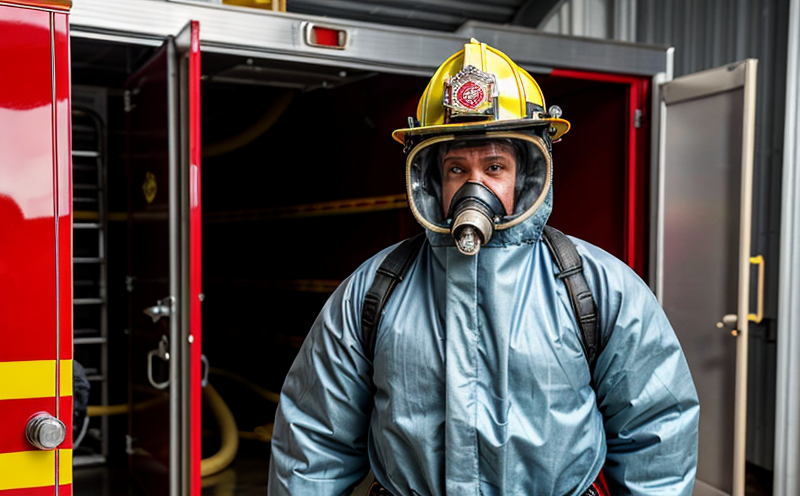Firefighter Gloves Dexterity and Grip Testing
The ability of firefighting gloves to provide dexterity and a secure grip is critical for firefighters when they are faced with dangerous situations. This testing ensures that the gloves do not impede the wearer's manual tasks, which can be crucial in emergency scenarios.
Firefighters often need to use tools such as axes, saws, or hoses while wearing protective gear. Gloves that offer a good balance between dexterity and grip are essential for these tasks. Poorly designed gloves may compromise the firefighter’s ability to perform necessary actions quickly and safely. This testing ensures that the gloves meet strict industry standards.
The International Organization for Standardization (ISO) provides specific guidelines on how to conduct this type of testing, ensuring consistency across different testing facilities worldwide. ISO 24095-3 is one such standard that specifies the methods for determining the dexterity and grip performance of gloves used by firefighters.
During the test, various activities are performed using a set of tools designed to simulate real-world firefighting tasks. These tests assess how well the firefighter can manipulate these tools while wearing the gloves. The evaluation includes measures such as time taken to complete each task and the ease with which the task is accomplished.
The testing process starts by selecting appropriate samples from a batch of gloves that are to be tested. Specimens must be conditioned according to ISO standards before they can undergo the dexterity and grip tests. Proper conditioning ensures accurate results, reflecting real-world use conditions.
Once the specimens have been prepared, they are placed on specially designed test fixtures that simulate typical firefighting gloves worn by firefighters. The testing apparatus includes various tools such as a wrench, axe handle, and fire hose couplings, which are used to assess grip strength and dexterity.
The tests involve a series of tasks that require the firefighter to perform specific actions using these simulated tools. For instance, the firefighter might be asked to open a valve on a fire hose or unscrew a wrench. The time taken to complete each task is recorded along with the ease of performing the action.
After completing all the tasks, the test results are analyzed to determine if the gloves meet the specified performance criteria. Compliance with ISO standards ensures that firefighters can rely on their protective gear in critical situations. Non-compliance would mean that the gloves might hinder a firefighter's ability to perform essential tasks effectively.
Understanding and adhering to these testing protocols is vital for ensuring that firefighting equipment meets strict safety and performance requirements. By conducting such tests, manufacturers can ensure that their products are reliable and effective in real-world situations.
Scope and Methodology
The scope of the testing for firefighter gloves dexterity and grip is broad and includes multiple aspects to ensure comprehensive evaluation. The methodology involves a series of standardized tests that simulate real-world conditions firefighters encounter.
- Grip Strength Test: This test measures how well the gloves allow the firefighter to hold onto tools or objects, ensuring they can perform tasks without slipping.
- Dexterity Test: Here, the focus is on evaluating the ease with which firefighters can manipulate small tools and perform fine motor tasks. This includes activities such as turning a valve or adjusting a hose nozzle.
The methodology also involves conditioning the gloves to ensure they are in optimal condition for testing. This step is critical because the performance of the gloves might vary depending on their state. Proper conditioning helps eliminate variables that could affect test results.
After conditioning, the gloves are fitted onto a mannequin designed to mimic the shape and size of a typical firefighter's hand. This ensures that all tests are conducted under controlled conditions, providing consistent data.
The testing apparatus used includes various tools such as wrenches, axes, and hoses, which simulate real-world firefighting scenarios. These tools help in evaluating both grip strength and dexterity by simulating the tasks firefighters need to perform during an emergency.
Once the tests are completed, the data is analyzed using specific criteria outlined in ISO 24095-3. Compliance with these standards ensures that the gloves meet the necessary performance levels required for firefighter safety and effectiveness.
Industry Applications
- Fire Service: Firefighters who are responsible for extinguishing fires and rescuing people rely on gloves that provide both dexterity and a secure grip.
- Emergency Services: Paramedics and other emergency responders need gloves that allow them to perform critical tasks efficiently, ensuring they can reach victims quickly and safely.
- Hazardous Materials Response: Personnel dealing with hazardous materials must have gloves that do not impede their ability to handle dangerous substances while maintaining a secure grip.
Quality and Reliability Assurance
The quality and reliability assurance of firefighter gloves are paramount for ensuring that firefighters can rely on their protective gear during critical situations. Regular testing helps maintain the integrity and performance of these gloves.
First, manufacturers must ensure that they use high-quality materials in the production process. This includes selecting appropriate fabrics, liners, and reinforcements that meet the required specifications. The choice of materials significantly impacts the overall performance of the gloves.
Secondly, rigorous quality control measures are implemented at every stage of manufacturing to catch any defects or inconsistencies early on. This ensures that only high-quality products reach the market.
Thirdly, ongoing testing is conducted to verify that the gloves continue to meet performance standards over time. This includes periodic testing of both new batches and existing stock to ensure consistency in quality.
Finally, feedback from firefighters who use these gloves helps identify any areas for improvement or potential issues. Incorporating this feedback into the design and manufacturing process can lead to even better-performing products.





